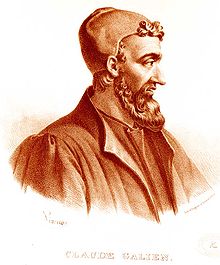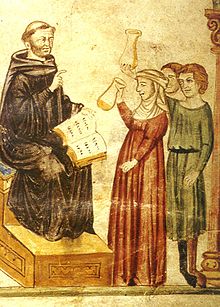Galen and the four "humors"
 In the Middle Ages, European medicine was dominated by the ideas of Galen (pictured) and the theory of the four humors. Surviving Greek and Roman texts, usually preserved in monasteries, were used as a basis for what little scientific medicine was practised. Medieval doctors were great believers in blood letting, so sick people were cut and allowed to bleed into a bowl. People believed that bleeding would keep you healthy, so monks were given regular blood letting sessions. Many people, however, simply placed their face in God or the church to heal their sicknesses.
In the Middle Ages, European medicine was dominated by the ideas of Galen (pictured) and the theory of the four humors. Surviving Greek and Roman texts, usually preserved in monasteries, were used as a basis for what little scientific medicine was practised. Medieval doctors were great believers in blood letting, so sick people were cut and allowed to bleed into a bowl. People believed that bleeding would keep you healthy, so monks were given regular blood letting sessions. Many people, however, simply placed their face in God or the church to heal their sicknesses.
Medieval doctors also prescribed laxatives for purging and enemas were administered with a greased tube attached to a pigs bladder. Together with bloodletting, these were designed to "re-balance" the four humors (blood, black bile, yellow bile & phlegm).
Doctors prescribed baths in scented water. They used salves and ointments, not just for skin complaints but because they believed it was important, when treating many illnesses, to prevent heat or moisture escaping from the affected part of the body; they believed that ointments would do that.
Despite some overlap with Ancient Arab medicine and with the developments in traditional Chinese medicine, Medieval medicine remained firmly rooted in religion and witchcraft, with monks and monasteries providing what little medical expertise there was. Medieval monks did, however, establish the technique of examining a patient's urine (uroscopy, pictured). The color, smell, and even the taste, of urine were thought to be important and a number of simple diagnoses (e.g. diabetes) could be made on this basis.
was. Medieval monks did, however, establish the technique of examining a patient's urine (uroscopy, pictured). The color, smell, and even the taste, of urine were thought to be important and a number of simple diagnoses (e.g. diabetes) could be made on this basis.
Astrology was also an important part of Medieval medicine. Doctors believed that people born under certain zodiacal signs were more susceptible to certain ailments and, to this day, astrologists still hold this belief.
Medieval surgery
The emergence of universities (especially in Italy & France) allowed surgery to develop as a discipline that needed to be learned and taught as a uniform practice. The University of Padua was one of the Italian universities that took a lead in teaching medicine, identifying and treating of diseases and ailments, performing autopsies and assessing the workings of the body. The most prestigious and famous part of the University is the oldest surviving theatre in which students studed anatomy by watching their teachers perform public dissections.
More about the University of Padua

In the 13th century England, however, a different type of craftsmen emerged. He (or she, because not all were male) was the barber-surgeon. The barber-surgeon cut hair, pulled teeth, set broken bones and performed simple amputations. During this time, it was also expected that the surgeons should have a good knowledge of human anatomy and be accountable for any consequences as a result of their interventions.
War created a great opportunity for surgical practice but, with the passage of time, wars became less frequent and the surgeon's involvement became less. Alongside this, there was a resurgence in the use of medical herbalism, guided by the translation of important publications such as the herbal recipes from the "Materia Medica" (pictured) of Dioscorides.
Further developments
It was only after the Renaissance, from the mid-1450s onwards, that medical practices began to advance with new treatments for disease such as syphilis.
Huge medical catastrophes such as plague, measles, smallpox & infuenza had a major influence on quality of life and were, sadly, spread into the indigenous people of other countries as a result of the quest for exploration of foreign climes, especially the Americas.
← Back to Time Corridor